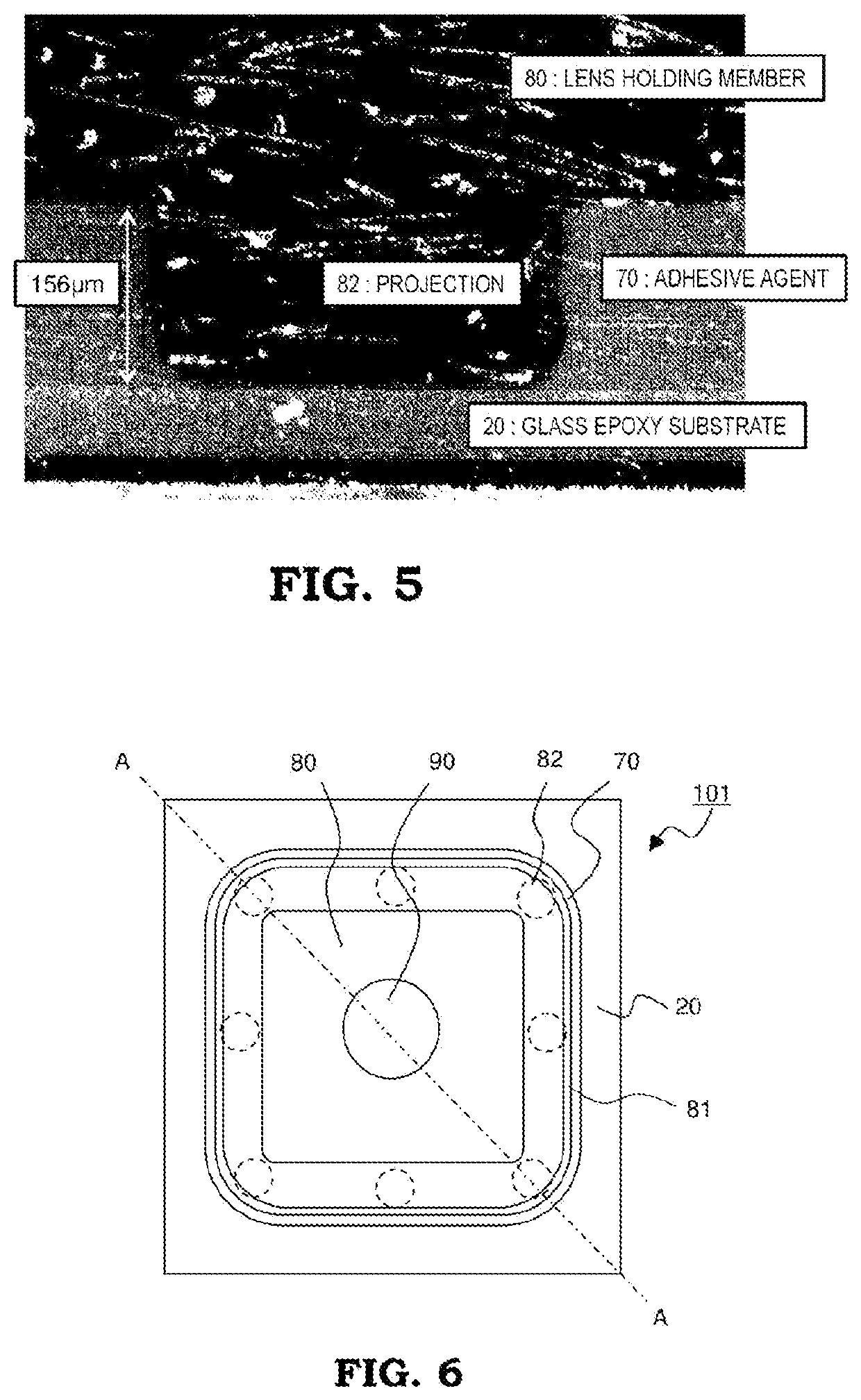Optical sensor module
a technology of optical sensor module and lens holding member, which is applied in the direction of mounting, semiconductor devices, instruments, etc., can solve the problems of optical sensor module not being able to correctly receive light, the thickness of adhesive agent between the lens holding member and the substrate after the lens holding member is mounted thereon cannot be controlled, and the optical sensor module cannot receive light correctly
- Summary
- Abstract
- Description
- Claims
- Application Information
AI Technical Summary
Benefits of technology
Problems solved by technology
Method used
Image
Examples
embodiment 1
[0029]FIG. 1 is a plan view showing the schematic structure of an optical sensor module 101 according to embodiment 1, and FIG. 2 is a sectional view along line A-A in FIG. 1. The optical sensor module 101 includes, as basic components, an infrared detector 10 as a photodetector, a glass epoxy substrate 20 as a substrate, and a lens holding member 80 integrated with a lens 90 by inserting the lens 90 after molding and then caulking the periphery of the lens 90 with resin. The infrared detector 10 is adhered to one surface of the glass epoxy substrate 20 by Ag paste 60, and thus fixed and stored inside the lens holding member 80. The lens 90 for transmitting infrared rays therethrough and focusing the infrared rays is integrally fixed to the lens holding member 80, and a bottom surface 84 of the lens holding member 80 is adhered to the glass epoxy substrate 20 by an adhesive agent 70.
[0030]In FIG. 1 and FIG. 2, only basic constituent parts in the optical sensor module 101 are shown, ...
embodiment 2
[0057]FIG. 11 is a plan view showing the schematic structure of an optical sensor module 102 according to embodiment 2, and FIG. 12 is a sectional view along line A-A in FIG. 11. The optical sensor module 102 according to the present embodiment 2 basically has the same structure as the optical sensor module 101 according to embodiment 1, but has difference as described below. Here, the difference will be mainly described and description of the same constituent parts is omitted. FIG. 11 and FIG. 12 are schematic views showing only basic constituent parts in the optical sensor module 102, and description of the other constituent parts is omitted.
[0058]In embodiment 1, the infrared detector 10 is sealed by making the inside of the lens holding member 80 into a vacuum state after the entire periphery of the bottom surface 84 of the lens holding member 80 is adhered by the adhesive agent 70. On the other hand, in the present embodiment 2, as shown in FIG. 11 and FIG. 12, a light transmit...
embodiment 3
[0064]FIG. 13 is a plan view showing the schematic structure of an optical sensor module 103 according to embodiment 3, and FIG. 14 is a sectional view along line A-A in FIG. 13. Also the optical sensor module 103 according to the present embodiment 3 basically has the same structure as the optical sensor module 101 according to embodiment 1, but has difference as described below. Here, the difference will be mainly described and description of the same constituent parts is omitted. FIG. 13 and FIG. 14 are schematic views showing only basic constituent parts in the optical sensor module 103, and description of the other constituent parts is omitted.
[0065]In the present embodiment 3, as shown in FIG. 13 and FIG. 14, at the distal end of each projection 82 provided on the bottom surface 84 of the lens holding member 80, a positioning projection 82a extending in a truncated cone shape from the distal end of the projection 82 is formed integrally with the projection 82. A positioning ho...
PUM
 Login to View More
Login to View More Abstract
Description
Claims
Application Information
 Login to View More
Login to View More - R&D
- Intellectual Property
- Life Sciences
- Materials
- Tech Scout
- Unparalleled Data Quality
- Higher Quality Content
- 60% Fewer Hallucinations
Browse by: Latest US Patents, China's latest patents, Technical Efficacy Thesaurus, Application Domain, Technology Topic, Popular Technical Reports.
© 2025 PatSnap. All rights reserved.Legal|Privacy policy|Modern Slavery Act Transparency Statement|Sitemap|About US| Contact US: help@patsnap.com



